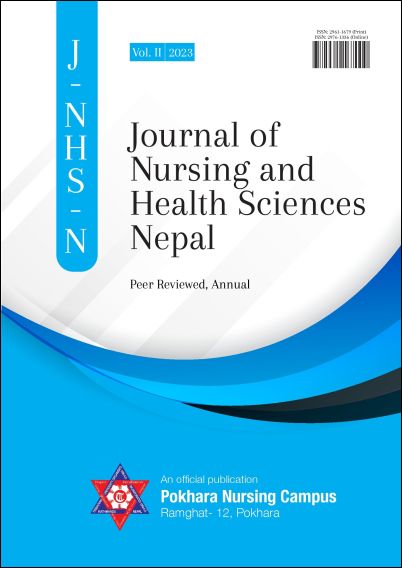Challenges of Bachelor Level Nursing Students in Clinical Learning Environment
DOI:
https://doi.org/10.3126/jnhsn.v2i1.66428Keywords:
Challenges, clinical learning environment, nursing students, NepalAbstract
Introduction: Students’ exposure to clinical learning environment is one of the most important factors affecting the teaching-learning process in clinical settings. Identifying challenges of nursing students in the clinical learning environment could improve guidance in clinical setting and enhance the quality of its planning and promotion of the students. The study aims to assess nursing students’ challenges in the clinical learning environment.
Methods: Mixed method was used to collect the data among bachelor level nursing students of Pokhara Nursing Campus. Self-administered structured questionnaire for quantitative analysis and focus group discussion was done for qualitative data using FGD guideline. Complete enumeration was done quantitative data and sample was selected purposively from different academic years for FGD.
Results: About 92% of students reported shortage of staff, 91.0% said content of theory classes is not fully applicable to the clinical situation, 86.4% reported clinical surrounding is not helpful for instruction, 82.0% expressed deficit of required resources, facilities, materials and equipment necessary for clinical practice, 73.8% reported insufficient numbers of clinical supervisors. Likewise students expressed that teachers were competent in students' evaluation (80.3%), provide feedback and reflection timely (86.1%), effective role model (78.7%), monitor and evaluate student’s development (84.4%), provide encouragement to students and detects students’ interest and motivation (82.0%) and considers students’ feelings (86.1%). Insufficient number of clinical supervisors in the ward, inadequate guidelines for paperwork, no feedback for submitted paperwork was the major challenges identified in qualitative data.
Conclusions: Insufficient number of staffs in the ward makes them to perform ward activities, theory-practice gap, inadequate learning resources to perform ward activities and facilities in the ward, unreadiness for clinical training, insufficient number of clinical supervisors were the major challenges recognized.
Downloads
Downloads
Published
How to Cite
Issue
Section
License
Copyright (c) 2023 The Author(s)

This work is licensed under a Creative Commons Attribution 4.0 International License.
This license enables reusers to distribute, remix, adapt, and build upon the material in any medium or format, so long as attribution is given to the creator. The license allows for commercial use.




